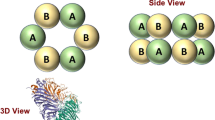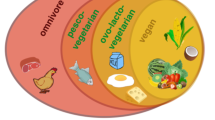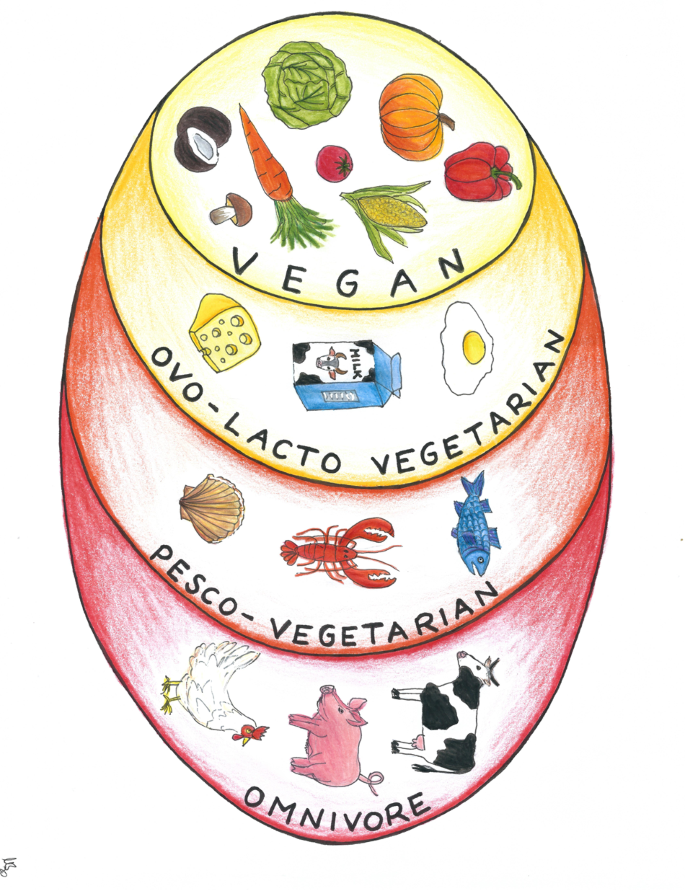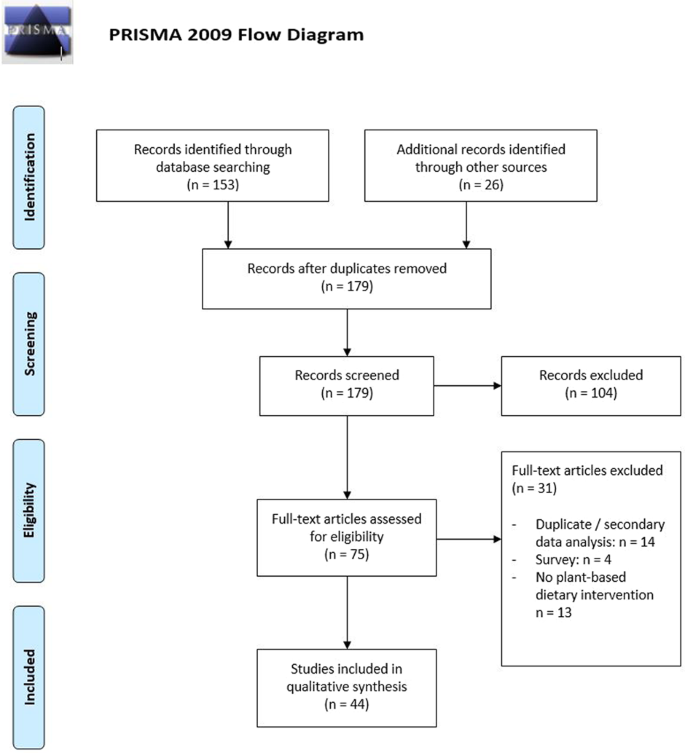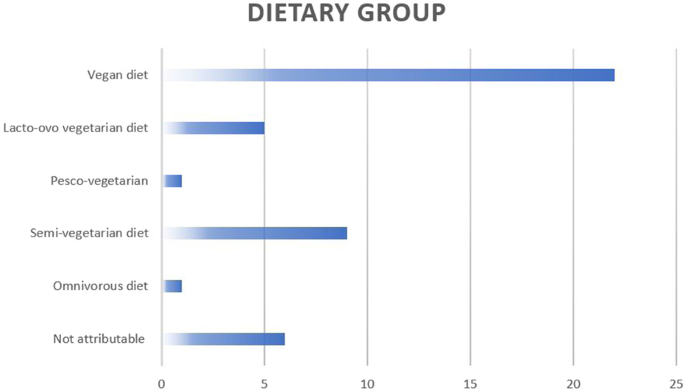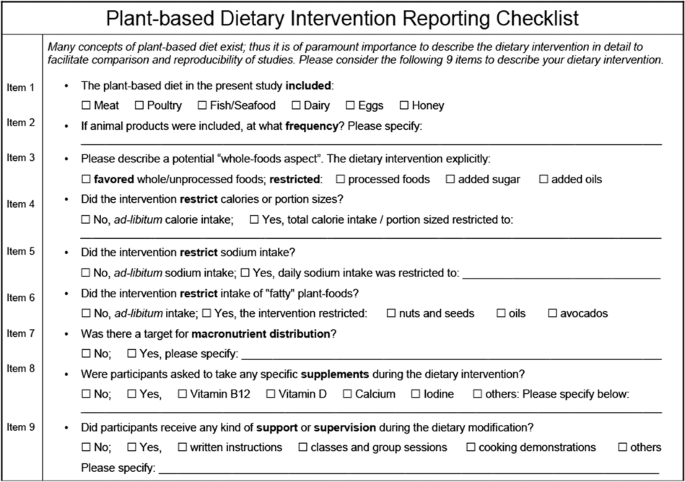Abstract
Within the last decades, plant-based diets have received increasing interest for their potential benefits to human and environmental health. The concept of plant-based diet, however, varies widely in its definition. Current definitions range from the exclusion of all animal products to diets that include meat, fish, and dairy in varying quantities. Therefore, the main objectives of this review were twofold: (a) to investigate how researchers use the term plant-based diet in nutrition intervention studies and (b) what types of food a plant-based diet may include. Searching two databases, we found that the term “plant-based diet” evokes varying ideas to researchers and clinicians. Fifty percent of the retrieved studies that included a plant-based dietary intervention completely proscribed animal products and used the term plant-based diet interchangeably with a vegan diet. In contrast, an ~33% of trials included dairy products and 20% of dietary interventions emphasized a semi-vegetarian dietary pattern. Based on specific examples, we point out how the usage of the umbrella term “plant-based diet” may cause significant ambiguity. We often encountered incomplete descriptions of plant-based dietary interventions, which makes comparison and reproducibility of studies difficult. As a consequence, we urge others to use the term “plant-based diet” only in conjunction with a detailed dietary description. To facilitate this process, we provide a template of a standardized plant-based intervention reporting checklist. Finally, the present review also highlights the urgent need for a consensus definition of the term plant-based diet and its content.
Similar content being viewed by others
Introduction
Chronic diseases are increasing in global prevalence and a leading cause of mortality in the world [1, 2]. Heart disease, metabolic syndrome, and type-2-diabetes are driven by unhealthy consumption patterns, including refined sugars, processed meats, and high-fat foods [3]. More recently, however, Western societies noticed an increasing interest in plant-based eating patterns that may favorably affect chronic diseases [4, 5]. Meat’s central place in the menus is being increasingly challenged [6], whereas plant-based diets, (emphasizing grains, vegetables, fruits, legumes, nuts, and seeds), are becoming increasingly popular [7, 8].
However, according to Williams and Patel, the concept of “plant-based diet” varies widely in its definition [9]. Some definitions of “plant-based diet” exclude all animal products [10, 11] while others emphasize that plant-based eating patterns “maximiz[e] consumption of nutrient-dense plant foods while minimizing processed foods, oils, and animal foods” [12]. A popular and widely accepted definition by Ostfeld recently pointed out that a plant-based diet excludes all animal products [11], whereas other researchers emphasized that a plant-based dietary pattern may include fish, poultry, and yogurt [13, 14].
Several well-known authorities in the field of nutrition use the term “plant-based diet” synonymously with the term “vegan diet” - implying automatically that a plant-based diet is characterized by the avoidance of all flesh foods and animal-derived ingredients [15, 16]. In contrast, other sources explicitly highlight that a plant-based diet does not mean “being vegetarian” [17] or vegan [18].
The term plant-based diet is a rather new term that has been introduced by the scientific community to describe eating patterns that emphasize a large proportion of plant-dominant foods [19]. Examples include both a vegan and a vegetarian diet (Fig. 1).
From right to left: vegan diet (excluding all flesh foods and animal products), lacto-ovo-vegetarian diet (excluding meat, fish, or poultry but including eggs and dairy), pesco-vegetarian diet (excluding meat or poultry but including fish) and omnivorous diet (containing all food groups) [56]. Modified from Medawar et al. [4].
The inconsistent usage of the term “plant-based diet”, however, may cause confusion and ambiguity among researchers, clinicians and the general public. Questions arise as to whether a plant-based diet should, by definition, include animal products or not? What does the term plant-based diet actually refer to and how can physicians advocate for something that is not clearly defined?
Since the term “plant-based diet” appears to evoke substantially varying concepts to researchers and clinicians, this review investigated how the medical community uses this term in scientific publications. The main objectives of this review were twofold: (a) to understand how researchers define the term “plant-based diet” in nutrition intervention studies and (b) how frequently this term is used interchangeably with other diets that are more clearly defined (e.g. the vegan diet, a lacto-ovo-vegetarian diet, a pesco-vegetarian diet, etc.).
Methods
The electronic database of PubMed was searched using the keywords “Diet”, “Nutrition”, “Intervention” and “Plant-based” combined into the following search string: “Plant-based AND (Diet OR Intervention OR Nutrition)”. We applied the filter “Clinical Trial” and considered only English language articles. Original articles and case reports were included in this review; reviews were not considered. Reference lists of the included articles were manually screened for additional studies to ensure that all relevant trials were identified. In addition to that, we used Google Scholar’s “cited by” function to broaden our search. This allowed us to identify additional studies that could not be retrieved from controlled databases [20]. We applied no time restriction. The entire review process was conducted by the author (MAS).
Articles were included if they reported a plant-based dietary intervention in human subjects, irrespective of age, gender, race, or ethnicity. To be eligible, articles had to include the term “plant-based diet” or a synonymous term (e.g. “plant-based dietary intervention”, etc.) in the abstract, the introduction or the methods section. We considered only interventions with a minimum duration of 1 week. Studies were included irrespective of their outcome, as we focused solely on the description of each intervention. We also included studies that combined the dietary intervention with other lifestyle modifications (e.g. smoking cessation, exercising, or meditation). Moreover, studies were included regardless of their setting and location (e.g. corporate setting, in- or outpatient setting, etc.).
We did not consider animal studies for this review. Studies that investigated the effects of a single group of plant foods (e.g. plant milks) or of supplements or a particular bioactive plant compound were excluded, as well. In addition to that, surveys about plant-based diets were not considered for this review.
We identified 153 articles that met the aforementioned criteria. Eligible articles were carefully screened for a definition of the term “plant-based diet” and for a description of the dietary intervention. In a second step, we examined whether animal products were allowed as part of the plant-based diet and whether the term “plant-based diet” was used interchangeably with other terms that are more clearly defined (Fig. 1).
Finally, we assigned the prescribed diet in each study to one of five pre-defined dietary groups (including the vegan diet, the lacto-ovo-vegetarian diet, the pesco-vegetarian diet, the semi-vegetarian diet and the omnivorous diet). For example, a diet focusing on whole grains, legumes and vegetables but also containing dairy products was assigned to the lacto-ovo-vegetarian group. The intention behind this process was to gain a better understanding of the concept of “plant-based diet” and to examine how the term is used in scientific studies. Figure 1 includes descriptions of the pre-defined dietary groups. We analyzed all data using Microsoft Excel (2016).
Results
The initial search using the electronic database of PubMed yielded 153 articles published between 1992 and October 2020. We identified an additional 26 records by manually screening the reference lists of the retrieved articles and by the usage of Google Scholar. The reference management software “Zotero” (Roy Rosenzweig Center for History and New Media. (2016) Zotero Computer software) was used to identify potential duplicates. We screened 179 records in total. After examination of abstract and title, 75 records remained eligible for full-text review (Fig. 2).
Occasionally, multiple studies reported different outcomes of the same intervention (e.g. when authors performed a secondary data analysis). We included only one report when multiple publications were linked to the same intervention or the same group of participants. In case of any doubts, we contacted the authors of the respective publications via email to confirm that the sample was the same.
The search revealed a total of 44 intervention studies that investigated the effects of a plant‐based diet (Table 1). We identified 37 clinical studies and 7 case reports. Table 1 provides an overview of the study characteristics (in a reversed chronological order) and shows how the term “plant-based diet” was used in the respective studies.
The majority of the included studies was done in the United States of America. Other countries of origin included (in an alphabetical order): Australia, Canada, Germany, Italy, Japan, New Zealand and Slovenia. More than 2/3 of the included studies were published after 2010 (n = 31/44), reflecting the aforementioned growing interest in plant-based diets within the scientific community. We refrained from calculating the mean duration of the studies because this review also includes multiple case reports (n = 7) without a precise duration.
All studies included either a definition or a short description of the term “plant-based diet” (n = 44/44). However, the descriptions of the dietary interventions varied significantly in detail. In several cases it was impossible for us to determine which foods were in- and excluded in a particular plant-based dietary intervention.
Table 1 shows bulleted summaries of the dietary interventions. Five studies used the term “plant-based diet” interchangeably with the term “vegan diet” [21,22,23,24,25]. Fifty percent (n = 22/44) of the included studies completely proscribed animal products. More than 1/3 of studies (n = 17/44) included animal products as part of plant-based diet. Occasionally, the dietary description was inconclusive and it was not exactly specified to which extent animal products were allowed [26,27,28,29].
For example, the authors of a 2008 study used a vegan diet that excluded all animal products but supplemented it with fish oil [29]. Thus, the (dietary) intervention was technically not vegan. Another example is a 2018 study by Valdez et al. [26]. The authors investigated the feasibility of engaging college students in a 10-day plant-based dietary intervention. The intervention emphasized the value of a whole-food plant-based diet and minimized processed foods, saturated fats and added sugars. This was also represented in the provided meals at a local restaurant offering whole foods plant-based (vegan) options. While the intervention was presumably vegan, the authors did not clarify whether animal foods were “only” minimized or fully excluded.
The literature research also revealed a case report by Massera et al., who reported a whole-food plant-based diet to reverse angina without medication or interventional procedures [27]. The dietary intervention consisted primarily of vegetables, fruits, whole grains, potatoes, beans, legumes, and nuts. Again, it was not fully clear whether small amounts of animal products were allowed or proscribed. Based on the studies’ reference list and other studies of this particular group [30], however, one may assume that the dietary intervention was technically vegan. Nevertheless, all 4 aforementioned articles were not considered in the final dietary group assignment (see below and Fig. 3).
Finally, the authors of a 2014 study carefully dissected the umbrella term “plant-based diet” and discussed the different dietary patterns used in their study. The study included a vegan diet (excluding all animal products), a vegetarian diet (excluding meat and seafood), a pesco-vegetarian diet, a semi-vegetarian diet and an omnivorous diet [31]. This study was not considered in the final dietary group assignment.
Approximately 20% (n = 9/44) of the retrieved studies allowed participants to consume meat and fish during the plant-based dietary intervention. Moreover, a plant-based diet contained dairy products in 34% (n = 15/44) of the included studies. Increased consumption of plant foods was a feature of all plant-based dietary interventions in all studies (n = 44/44). Almost 30% (n = 13/44) of studies included a “whole-food” aspect and used the prefix “whole-food” to describe the plant-based dietary intervention in greater detail.
In the last step, we assigned the prescribed diet in each study to one of five pre-defined dietary groups. These groups included a vegan diet, a lacto-ovo-vegetarian diet, a pesco-vegetarian diet, a semi-vegetarian diet and an omnivorous diet. In a few cases (n = 6), an attribution was impossible due to missing information or inconclusive dietary descriptions. As displayed in Fig. 3, the majority of studies prescribed a technically vegan diet. It is noteworthy that ~20% of studies allowed participants a semi-vegetarian diet, including fish and meat products.
Discussion
The term “plant-based diet” evokes different ideas to researchers, scientists and clinicians. The primary aim of this review was to gain a better understanding of how scientists and clinicians define this term. Moreover, we sought to investigate how the term plant-based diet is used in scientific publications and nutrition intervention studies. A broad search strategy revealed 44 studies reporting a plant-based dietary intervention. Fifty percent of the included studies completely proscribed animal products. In ~20% of the retrieved studies, a plant-based diet included meat and fish. One-third of studies allowed the consumption of dairy products. While the majority of trials prescribed a technically vegan diet, 20% of trials included a semi-vegetarian eating pattern.
Our review confirmed the hypothesis that the term “plant-based diet” is used inconsistently within intervention studies. We also demonstrated that researchers have varying ideas about the content of a plant-based diet. Concepts range widely from a traditional vegan diet (excluding all animal-derived products) to a semi-vegetarian diet or even an omnivorous diet.
These findings may have important scientific and clinical implications. Clear definitions of a term or concept are necessary to allow for scientifically sound and reproducible results. According to Kampourakis, any kind of scientific discourse “has to involve concepts, the meaning of which ought to be clear among those participating in the discourse” [32]. The greater the flexibility in definitions and concepts, the less likely research findings are to be true [33]. In contrast, adherence to common standards and clear definitions is likely to reduce bias.
In the worst case, the absence of a clearly defined concept may lead to diametrically opposed results in scientific studies. This can be easily translated into clinical practice and is shown hereafter with the aid of two specific examples.
In 1998, Yamashita et al. compared two (isoenergetic) diets designed to lead to weight loss in 36 overweight or obese women in a 16-week parallel-design trial [34]. One arm of the study emphasized red meat and the other arm emphasized soybeans as the major protein source. Participants with a preference for daily meat consumption were allocated to the first arm. The second arm included subjects with a preference for plant foods who (habitually) ate more chicken and fish than red meat. Nutrients calculated from planned menus revealed a cholesterol content of 54 mg/1000 kcal in the second group. This serves an indirect indicator that their diet contained substantial amounts of animal products, because strict plant-based diets are usually much lower in cholesterol [35]. The authors found that weight loss was equal with both diets and concluded in their abstract that weight loss “occurred equally with the meat-based and plant-based diet” [34].
Seven years later, Barnard et al. published the results of a randomized clinical trial which examined the effects of a low-fat plant-based diet on body weight and metabolism [25]. Sixty-four postmenopausal, overweight women were randomly assigned to either a (low-fat) vegan diet or a control diet (based on the National Cholesterol Education Program guidelines). Adoption of a low-fat, vegan diet was associated with a mean weight loss of 5.8 (±3.2) kg in 14 weeks. Weight loss in the intervention group was significantly greater than in the control group (3.8(±2.8) kg) that regularly consumed meat and other animal products.
The two studies revealed contradicting results but were both published under the same umbrella term “plant-based diet” [25, 34]. The basic dilemma could not be clearer. In one of the studies, the term “plant-based diet” was used interchangeably with a vegan diet [25], whereas, in the other trial, the usage of the term “plant-based diet” implied the regular consumption of fish and chicken [34]. Although both diets were very different with regard to their food composition, the results were published under the same umbrella term.
The lack of a clear definition of the term ‘plant-based diet’ and its inconsistent usage may cause significant ambiguity among researchers and the public. The term ‘plant-based diet’ may therefore only be useful in the context of a clear definition and a thorough description of the applied dietary pattern. Otherwise, studies including “plant-based diets” are difficult to compare and hard to reproduce.
Reproducibility of research, however, is a fundamental tenet of good science and requires meticulous and complete reporting of interventions parameters [36]. This is particularly true for nutrition interventions, that vary from study to study in many methodological details [37]. To facilitate comparison (and reproducibility) of studies, we call for a standardized plant-based intervention reporting checklist. A template including nine items that primarily focuses on the description of the dietary intervention itself is provided below (Fig. 4).
Finally, one must pose the question whether it is justified to call a diet “plant-based” when it contains fish and chicken (at least) twice per week (as it was the case in Yamashita et al.) [34]. Should a plant-based diet contain animal products after all and if so, to what extent? What makes a plant-based diet and how much “plant-based” is necessary to exert health benefits? In the absence of a clear definition, a seemingly endless number of questions arise during a scientific discourse about plant-based dietary interventions. Although this could indeed stipulate valuable scientific discussions, one may not forget about the public health and environmental aspects behind this controversy, which have become particularly urgent during the last decades.
There is now a general consensus that diets link environmental and human health [38]. The global transition towards diets high in animal products, ultra-processed foods, and refined sugars exacts a heavy toll on planetary and human health [39, 40]. Diets high in saturated fat and meat products were frequently linked to a variety of chronic conditions, including obesity and type-2-diabetes [5, 41]. Moreover, they were associated with excessive land use, depletion of natural resources and a loss of biodiversity [40, 42]. Promoting animal-free diets that are abundant in land-sparing foods (such as vegetables) is therefore essential to boost environmental protection and human health [43, 44].
In this context, Fresán and Sabaté highlighted the alignment of environmental outcomes and human health for plant-sourced foods [39]. Plant foods are usually less resource-intensive than animal foods [45]. In addition, they were associated with beneficial effects on cardiovascular and metabolic disorders [4, 46, 47]. Plant-based diets are characterized by a reduced caloric density and a high nutrient density [48]. They also improve gut microbiota symbiosis [48], insulin sensitivity [49], beta-cell function [49, 50] and increase postprandial energy expenditure [51]. The improved postprandial metabolism after plant-based meals [52] and the reduced energy density of plant-based diets are two of the main reasons why this dietary pattern was frequently linked to weight loss [48, 49].
Reducing meat and animal product consumption is an effective way to adopt a healthier diet while simultaneously strengthening environmental protection. To promote plant-based eating patterns, however, large and well-designed public health campaigns are necessary. Physicians play an important role in this process as they are often seen as nutrition authorities and are well-positioned to deliver dietary advice and nutritional prescriptions [53, 54]. Another discussion about the value of plant-based nutrition could be a significant barrier to this development. Unfortunately, inconsistent usage of the term “plant-based diet” in the absence of clear definition of the term may exactly lead to such a discussion.
Therefore, it appears of utmost importance that future plant-based dietary interventions declare exactly to which extent animal products were included. A “plant-based dietary intervention” that includes a semi-vegetarian or even an omnivorous diet may lead to “false-negative” results (no health benefits) when compared to a plant-based diet that includes a vegan or lacto-ovo-vegetarian regimen.
Plant-based diets (and vegetarian diets in particular) are nowadays generally perceived in a positive light [55]. Dissonance about the term and its content should be resolved quickly to avoid potentially arising confusion in the general public. Otherwise, there will be a call for additional research examining the beneficial health and environmental effects of diets low (or free) in animal products. This call would inevitably translate into a substantial loss of time in the race against the growing burden of chronic non-communicable diseases and human-made environmental destruction. Thus, the authors of this paper finally argue that the term ‘plant-based diet’ should only be used in conjunction with a clear definition and a thorough description of its content.
This review has several strengths and limitations that warrant further consideration. The methodology employed in this review included a simple but easily reproducible search strategy with clearly defined in- and exclusion criteria. The outcome-independent search strategy revealed a broad spectrum of different studies. The biggest strength of this review is probably that its findings are of high translational value and highly applicable to future research studies in the field of plant-based nutrition. Our review revealed a problematic trend that requires a fast solution to allow for a better comparison between studies. The provided checklist may serve as an important guide to facilitate this process.
This review also has important limitations. Since the search strategy mainly relied on the electronic databases of PubMed and Google Scholar, it is not inconceivable that potentially relevant studies from other sources were missed. Moreover, it is likely that the English language restriction may also have limited the results.
Conclusion
The concept of “plant-based diet” varies widely in its definition and evokes varying ideas to researchers and clinicians. Many researchers use this term interchangeably with a vegan diet, as 50% of the included studies completely excluded animal products. In contrast, a noticeable amount of trials included dairy products or emphasized a semi-vegetarian dietary pattern. We argue that this inconsistent usage of the term “plant-based diet” may cause significant confusion and makes comparison of studies difficult. Therefore, we call for a rapid consensus definition. In the meantime, we suggest to use the term “plant-based diet” only in conjunction with a detailed dietary description. Our provided checklist may support researchers and clinicians in this process.
References
Nugent R. Chronic diseases in developing countries. Ann N. Y Acad Sci. 2008;1136:70–9.
Terzic A, Waldman S. Chronic diseases: the emerging pandemic. Clin Transl Sci. 2011;4:225–6.
Yach D, Kellogg M, Voute J. Chronic diseases: an increasing challenge in developing countries. Trans R Soc Trop Med Hyg. 2005;99:321–4.
Medawar E, Huhn S, Villringer A, Veronica WA. The effects of plant-based diets on the body and the brain: a systematic review. Transl Psychiatry. 2019;9:1–17.
Storz MA. Will the plant-based movement redefine physicians’ understanding of chronic disease? N. Bioeth. 2020;26:141–57.
Graça J, Calheiros MM, Oliveira A. Attached to meat? (Un)Willingness and intentions to adopt a more plant-based diet. Appetite. 2015;95:113–25.
Jakše B, Jakše B, Pinter S, Pajek J, Godnov U, Mis NF. Nutrient and Food Intake of Participants in a Whole-Food Plant-Based Lifestyle Program. J Am Coll Nutr. 2020;0:1–16.
Storz MA Is There a Lack of Support for Whole-Food, Plant-Based Diets in the Medical Community? Perm J. 2018;23. https://www.ncbi.nlm.nih.gov/pmc/articles/PMC6307547/.
Williams KA, Patel H. Healthy plant-based diet: what does it really mean? J Am Coll Cardiol. 2017;70:423–5.
Freeman AM, Morris PB, Barnard N, Esselstyn CB, Ros E, Agatston A, et al. Trending cardiovascular nutrition controversies. J Am Coll Cardiol. 2017;69:1172–87.
Ostfeld RJ. Definition of a plant-based diet and overview of this special issue. J Geriatr Cardiol. 2017;14:315.
Tuso PJ, Ismail MH, Ha BP, Bartolotto C. Nutritional update for physicians: plant-based diets. Perm J. 2013;17:61–6.
Shikany JM, Safford MM, Newby PK, Durant RW, Brown TM, Judd SE. Southern Dietary Pattern is Associated With Hazard of Acute Coronary Heart Disease in the Reasons for Geographic and Racial Differences in Stroke (REGARDS) Study. Circulation. 2015;132:804–14.
Akinyemiju T, Moore JX, Pisu M, Lakoski SG, Shikany J, Goodman M, et al. A prospective study of dietary patterns and cancer mortality among Blacks and Whites in the REGARDS cohort. Int J Cancer. 2016;139:2221–31.
Kahleova H, Tura A, Hill M, Holubkov R, Barnard ND. A Plant-Based Dietary Intervention Improves Beta-Cell Function and Insulin Resistance in Overweight Adults: A 16-Week Randomized Clinical Trial. Nutrients. 2018;10.
Kenneally S, Bristor D, Newman G, et al. The evidence supporting a plant-based diet for optimal health and prevention of chronic disease. https://plantbasedhealthprofessionals.com/wp-content/uploads/HE-KEY-BENEFITS-OF-PLANT-BASED-NUTRITION.pdf.
Livingstone K Why you should eat a plant-based diet, but that doesn’t mean being a vegetarian. The Conversation. Accessed 19 Feb 2021. http://theconversation.com/why-you-should-eat-a-plant-based-diet-but-that-doesnt-mean-being-a-vegetarian-78470.
Hemler EC, Hu FB. Plant-based diets for cardiovascular disease prevention: all plant foods are not created equal. Curr Atheroscler Rep. 2019;21:18.
Joshi S, McMacken M, Kalantar-Zadeh K. Plant-based diets for kidney disease: a guide for clinicians. Am J Kidney Dis. 2021;77:287–96.
Halevi G, Moed H, Bar-Ilan J. Suitability of Google Scholar as a source of scientific information and as a source of data for scientific evaluation—Review of the Literature. J Informetr. 2017;11:823–34.
Lederer A-K, Hannibal L, Hettich M, Behringer S, Spiekerkoetter U, Steinborn C, et al. Vitamin B12 Status Upon Short-Term Intervention with a Vegan Diet-A Randomized Controlled Trial in Healthy Participants. Nutrients. 2019;11.
Kahleova H, Dort S, Holubkov R, Barnard ND. A Plant-Based High-Carbohydrate, Low-Fat Diet in Overweight Individuals in a 16-Week Randomized Clinical Trial: The Role of Carbohydrates. Nutrients. 2018;10.
Bunner AE, Agarwal U, Gonzales JF, Valente F, Barnard ND. Nutrition intervention for migraine: a randomized crossover trial. J Headache Pain. 2014;15:69.
Mishra S, Xu J, Agarwal U, Gonzales J, Levin S, Barnard ND. A multicenter randomized controlled trial of a plant-based nutrition program to reduce body weight and cardiovascular risk in the corporate setting: the GEICO study. Eur J Clin Nutr. 2013;67:718–24.
Barnard ND, Scialli AR, Turner-McGrievy G, Lanou AJ, Glass J. The effects of a low-fat, plant-based dietary intervention on body weight, metabolism, and insulin sensitivity. Am J Med. 2005;118:991–7.
Valdez ES, Pottinger H, Urbon-Bonine A, Duncan B. Feasibility of engaging college students in a 10-day plant-based diet. Health Educ J. 2018;77:952–63.
Massera D, Zaman T, Farren GE, Ostfeld RJ. A Whole-Food Plant-Based Diet Reversed Angina without Medications or Procedures. Case Rep Cardiol. 2015;2015:978906.
Snyder DC, Morey MC, Sloane R, Stull V, Cohen HJ, Peterson B, et al. Reach out to ENhancE Wellness in Older Cancer Survivors (RENEW): design, methods and recruitment challenges of a home-based exercise and diet intervention to improve physical function among long-term survivors of breast, prostate, and colorectal cancer. Psychooncology. 2009;18:429–39.
Frattaroli J, Weidner G, Dnistrian AM, Kemp C, Daubenmier JJ, Marlin RO, et al. Clinical events in prostate cancer lifestyle trial: results from two years of follow-up. Urology. 2008;72:1319–23.
Massera D, Graf L, Barba S, Ostfeld R. Angina rapidly improved with a plant-based diet and returned after resuming a Western diet. J Geriatr Cardiol. 2016;13:364–6.
Turner-McGrievy GM, Davidson CR, Wilcox S. Does the type of weight loss diet affect who participates in a behavioral weight loss intervention? A comparison of participants for a plant-based diet versus a standard diet trial. Appetite. 2014;73:156–62.
Kampourakis K. On the Meaning of Concepts in Science Education. Sci Educ. 2018;27:591–2.
Ioannidis JPA. Why most published research findings are false. PLoS Med. 2005;2:e124.
Yamashita T, Sasahara T, Pomeroy SE, Collier G, Nestel PJ. Arterial compliance, blood pressure, plasma leptin, and plasma lipids in women are improved with weight reduction equally with a meat-based diet and a plant-based diet. Metabolism. 1998;47:1308–14.
Resnicow K, Barone J, Engle A, Miller S, Haley NJ, Fleming D, et al. Diet and serum lipids in vegan vegetarians: a model for risk reduction. J Am Diet Assoc. 1991;91:447–53.
McNutt M. Journals unite for reproducibility. Science. 2014;346:679.
Barnard ND, Willett WC, Ding EL. The Misuse of Meta-analysis in Nutrition Research. JAMA. 2017;318:1435–6.
Tilman D, Clark M. Global diets link environmental sustainability and human health. Nature. 2014;515:518–22.
Fresán U, Sabaté J. Vegetarian Diets: Planetary Health and Its Alignment with Human Health. Adv Nutr. 2019;10:S380–8.
Rizvi S, Pagnutti C, Fraser E, Bauch CT, Anand M. Global land use implications of dietary trends. PLoS One. 2018;13:e0200781.
Pan A, Sun Q, Bernstein AM, Schulze MB, Manson JE, Willett WC, et al. Red meat consumption and risk of type 2 diabetes: 3 cohorts of US adults and an updated meta-analysis. Am J Clin Nutr. 2011;94:1088–96.
Dopelt K, Radon P, Davidovitch N. Environmental Effects of the Livestock Industry: The Relationship between Knowledge, Attitudes, and Behavior among Students in Israel. Int J Environ Res Public Health. 2019;16.
Eshel G, Stainier P, Shepon A, Swaminathan A. Environmentally Optimal, Nutritionally Sound, Protein and Energy Conserving Plant Based Alternatives to U.S. Meat. Sci Rep. 2019;9:10345.
Storz MA. A Practical Guide for Physicians and Health Care Workers to Reduce Their Carbon Footprint in Daily Clinical Work. Perm J. 2018;22:17–145.
Shepon A, Eshel G, Noor E, Milo R. The opportunity cost of animal based diets exceeds all food losses. Proc Natl Acad Sci USA. 2018;115:3804–9.
Wright N, Wilson L, Smith M, Duncan B, McHugh P. The BROAD study: A randomised controlled trial using a whole food plant-based diet in the community for obesity, ischaemic heart disease or diabetes. Nutr Diabetes. 2017;7:e256.
Szabó Z, Erdélyi A, Gubicskóné Kisbenedek A, Ungár T, Lászlóné Polyák É, Szekeresné, et al. [Plant-based diets: a review]. Orv Hetil. 2016;157:1859–65.
Najjar RS, Feresin RG. Plant-Based Diets in the Reduction of Body Fat: Physiological Effects and Biochemical Insights. Nutrients. 2019;11:E2712.
Jardine MA, Kahleova H, Levin SM, Ali Z, Trapp CB, Barnard ND. Perspective: Plant-Based Eating Pattern for Type 2 Diabetes Prevention and Treatment: Efficacy, Mechanisms, and Practical Considerations. Adv Nutr. 2021;nmab063.
Storz MA. The Role of Vegan Diets in Lipotoxicity-induced Beta-cell Dysfunction in Type-2-Diabetes: A Narrative Review. J Popul Ther Clin Pharmacol. 2020;27:e22–38.
Marrone G, Guerriero C, Palazzetti D, Lido P, Marolla A, Di Daniele F, et al. Vegan Diet Health Benefits in Metabolic Syndrome. Nutrients. 2021;13:817.
Barnard ND, Levin SM, Yokoyama Y. A systematic review and meta-analysis of changes in body weight in clinical trials of vegetarian diets. J Acad Nutr Diet. 2015;115:954–69.
Truswell AS, Hiddink GJ, Blom J. Nutrition guidance by family doctors in a changing world: problems, opportunities, and future possibilities. Am J Clin Nutr. 2003;77:1089S–1092S.
Karlsen MC, Pollard KJ. Strategies for practitioners to support patients in plant-based eating. J Geriatr Cardiol. 2017;14:338–41.
Corrin T, Papadopoulos A. Understanding the attitudes and perceptions of vegetarian and plant-based diets to shape future health promotion programs. Appetite. 2017;109:40–7.
Turner-McGrievy G, Mandes T, Crimarco A. A plant-based diet for overweight and obesity prevention and treatment. J Geriatr Cardiol. 2017;14:369–74.
Singh PN, Steinbach J, Nelson A, Shih W, D’Avila M, Castilla S, et al. Incorporating an Increase in Plant-Based Food Choices into a Model of Culturally Responsive Care for Hispanic/Latino Children and Adults Who Are Overweight/Obese. Int J Environ Res Public Health. 2020;17. https://www.ncbi.nlm.nih.gov/pmc/articles/PMC7370208/.
Jakše B, Jakše B, Pinter S, Pajek J, Fidler Mis N. Whole-Food Plant-Based Lifestyle Program and Decreased Obesity. Am J Lifestyle Med. 2020. https://doi.org/10.1177/1559827620949205.
Crimarco A, Dias CH, Turner-McGrievy GM, Wilson M, Adams SA, Macauda M, et al. Outcomes of a short term dietary intervention involving vegan soul food restaurants on African American adults’ perceived barriers, benefits, and dietary acceptability of adopting a plant-based diet. Food Qual Preference. 2020;79:103788.
Morin É, Michaud-Létourneau I, Couturier Y, Roy M. A whole-food, plant-based nutrition program: evaluation of cardiovascular outcomes and exploration of food choices determinants. Nutrition. 2019;66:54–61.
Drost JM, Cook CB, Spangehl MJ, Probst NE, Mi L, Trentman TL. A Plant-Based Dietary Intervention for Preoperative Glucose Optimization in Diabetic Patients Undergoing Total Joint Arthroplasty. American Journal of Lifestyle Medicine. 2019. https://doi.org/10.1177/1559827619879073.
Chiba M, Nakane K, Tsuji T, Tsuda S, Ishii H, Ohno H, et al. Relapse Prevention by Plant-Based Diet Incorporated into Induction Therapy for Ulcerative Colitis: A Single-Group Trial. Perm J. 2019;23. https://www.ncbi.nlm.nih.gov/pmc/articles/PMC6499111/.
Campbell TM, Liebman SE. Plant-based dietary approach to stage 3 chronic kidney disease with hyperphosphataemia. BMJ Case Rep Cp 2019;12:e232080.
Campbell EK, Fidahusain M, Campbell Ii TM. Evaluation of an Eight-Week Whole-Food Plant-Based Lifestyle Modification Program. Nutrients. 2019;11.
Allen KE, Gumber D, Ostfeld RJ. Heart failure and a plant-based diet. a case-report and literature review. Front Nutr. 2019;6:82.
Towery P, Guffey JS, Doerflein C, Stroup K, Saucedo S, Taylor J. Chronic musculoskeletal pain and function improve with a plant-based diet. Complement Ther Med. 2018;40:64–9.
Ramal E, Champlin A, Bahjri K. Impact of a Plant-Based Diet and Support on Mitigating Type 2 Diabetes Mellitus in Latinos Living in Medically Underserved Areas. Am J Health Promot. 2018;32:753–62.
Najjar RS, Moore CE, Montgomery BD. A defined, plant-based diet utilized in an outpatient cardiovascular clinic effectively treats hypercholesterolemia and hypertension and reduces medications. Clin Cardiol. 2018;41:307–13.
Beauchesne AB, Goldhamer AC, Myers TR. Exclusively plant, whole-food diet for polypharmacy due to persistent atrial fibrillation, ischaemic cardiomyopathy, hyperlipidaemia and hypertension in an octogenarian. BMJ Case Rep. 2018;11.
Null G, Pennesi L. Diet and lifestyle intervention on chronic moderate to severe depression and anxiety and other chronic conditions. Complement Ther Clin Pract. 2017;29:189–93.
Gonciulea AR, Sellmeyer DE. The effect of dietary protein source on serum lipids: Secondary data analysis from a randomized clinical trial. J Clin Lipidol. 2017;11:46–54.
Evans J, Magee A, Dickman K, Sutter R, Sutter C. A Plant-Based Nutrition Program. Am J Nurs. 2017;117:56–61.
Choi EY, Allen K, McDonnough M, Massera D, Ostfeld RJ. A plant-based diet and heart failure: case report and literature review. J Geriatr Cardiol. 2017;14:375–8.
Yadav V, Marracci G, Kim E, Spain R, Cameron M, Overs S, et al. Low-fat, plant-based diet in multiple sclerosis: a randomized controlled trial. Mult Scler Relat Disord. 2016;9:80–90.
Macknin M, Kong T, Weier A, Worley S, Tang AS, Alkhouri N, et al. Plant-based, no-added-fat or American Heart Association diets: impact on cardiovascular risk in obese children with hypercholesterolemia and their parents. J Pediatr. 2015;166:953–9.
Guthrie GE, Bogue RJ. Impact of a Shared Medical Appointment Lifestyle Intervention on Weight and Lipid Parameters in Individuals with Type 2 Diabetes: A Clinical Pilot. J Am Coll Nutr. 2015;34:300–9.
Clinton CM, O’Brien S, Law J, Renier CM, Wendt MR. Whole-foods, plant-based diet alleviates the symptoms of osteoarthritis. Arthritis. 2015;2015:708152.
Bunner AE, Wells CL, Gonzales J, Agarwal U, Bayat E, Barnard ND. A dietary intervention for chronic diabetic neuropathy pain: a randomized controlled pilot study. Nutr Diabetes. 2015;5:e158.
Merrill RM, Aldana SG. Consequences of a plant-based diet with low dairy consumption on intake of bone-relevant nutrients. J Women’s Health. 2009;18:691–8.
Daubenmier JJ, Weidner G, Sumner MD, Mendell N, Merritt-Worden T, Studley J, et al. The contribution of changes in diet, exercise, and stress management to changes in coronary risk in women and men in the multisite cardiac lifestyle intervention program. Ann Behav Med. 2007;33:57–68.
Frattaroli J, Weidner G, Merritt-Worden TA, Frenda S, Ornish D. Angina pectoris and atherosclerotic risk factors in the multisite cardiac lifestyle intervention program. Am J Cardiol. 2008;101:911–8.
Saxe GA, Major JM, Nguyen JY, Freeman KM, Downs TM, Salem CE. Potential attenuation of disease progression in recurrent prostate cancer with plant-based diet and stress reduction. Integr Cancer Ther. 2006;5:206–13.
Gardner CD, Coulston A, Chatterjee L, Rigby A, Spiller G, Farquhar JW. The effect of a plant-based diet on plasma lipids in hypercholesterolemic adults: a randomized trial. Ann Intern Med. 2005;142:725–33.
Berrino F, Bellati C, Secreto G, Camerini E, Pala V, Panico S, et al. Reducing bioavailable sex hormones through a comprehensive change in diet: the diet and androgens (DIANA) randomized trial. Cancer Epidemiol Biomark Prev. 2001;10:25–33.
Colombo C, Muti P, Pala V, Cavalleri A, Venturelli E, Locardi M, et al. Plant-based diet, serum fatty acid profile, and free radicals in postmenopausal women: the diet and androgens (DIANA) randomized trial. Int J Biol Markers. 2005;20:169–76.
Hoffmann I, Groeneveld MJ, Boeing H, Koebnick C, Golf S, Katz N, et al. Giessen Wholesome Nutrition Study: relation between a health-conscious diet and blood lipids. Eur J Clin Nutr. 2001;55:887–95.
Koebnick C, Plank-Habibi S, Wirsam B, Gruendel S, Hahn A, Meyer-Kleine C, et al. Double-blind, randomized feedback control fails to improve the hypocholesterolemic effect of a plant-based low-fat diet in patients with moderately elevated total cholesterol levels. Eur J Clin Nutr. 2004;58:1402–9.
Spiller GA, Miller A, Olivera K, Reynolds J, Miller B, Morse SJ, et al. Effects of plant-based diets high in raw or roasted almonds, or roasted almond butter on serum lipoproteins in humans. J Am Coll Nutr. 2003;22:195–200.
Koertge J, Weidner G, Elliott-Eller M, Scherwitz L, Merritt-Worden TA, Marlin R, et al. Improvement in medical risk factors and quality of life in women and men with coronary artery disease in the Multicenter Lifestyle Demonstration Project. Am J Cardiol. 2003;91:1316–22.
Saxe GA, Hébert JR, Carmody JF, Kabat-Zinn J, Rosenzweig PH, Jarzobski D, et al. Can diet in conjunction with stress reduction affect the rate of increase in prostate specific antigen after biochemical recurrence of prostate cancer? J Urol. 2001;166:2202–7.
Acknowledgements
The author would like to thank Dr. Maria Brommer for providing Fig. 1 for this publication and Prof. Dr. Huber for critical reading.
Funding
Open Access funding enabled and organized by Projekt DEAL.
Author information
Authors and Affiliations
Contributions
MAS is the sole author of this review. MAS was responsible for designing the review protocol, writing the protocol and report, conducting the search, screening potentially eligible studies, extracting and analyzing data, interpreting results and drafting the manuscript.
Corresponding author
Ethics declarations
Competing interests
The author declares no competing interests.
Additional information
Publisher’s note Springer Nature remains neutral with regard to jurisdictional claims in published maps and institutional affiliations.
Rights and permissions
Open Access This article is licensed under a Creative Commons Attribution 4.0 International License, which permits use, sharing, adaptation, distribution and reproduction in any medium or format, as long as you give appropriate credit to the original author(s) and the source, provide a link to the Creative Commons license, and indicate if changes were made. The images or other third party material in this article are included in the article’s Creative Commons license, unless indicated otherwise in a credit line to the material. If material is not included in the article’s Creative Commons license and your intended use is not permitted by statutory regulation or exceeds the permitted use, you will need to obtain permission directly from the copyright holder. To view a copy of this license, visit http://creativecommons.org/licenses/by/4.0/.
About this article
Cite this article
Storz, M.A. What makes a plant-based diet? a review of current concepts and proposal for a standardized plant-based dietary intervention checklist. Eur J Clin Nutr 76, 789–800 (2022). https://doi.org/10.1038/s41430-021-01023-z
Received:
Revised:
Accepted:
Published:
Issue Date:
DOI: https://doi.org/10.1038/s41430-021-01023-z
This article is cited by
-
Defining “plant-based meats”
European Journal of Clinical Nutrition (2024)
-
Protein content and amino acid composition in the diet of Danish vegans: a cross-sectional study
BMC Nutrition (2023)
-
An Update on the Effects of Plant-Based Diets on Cardiometabolic Factors in Adults with Type 2 Diabetes Mellitus
Current Cardiovascular Risk Reports (2022)

